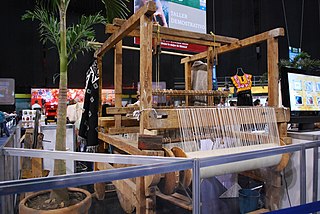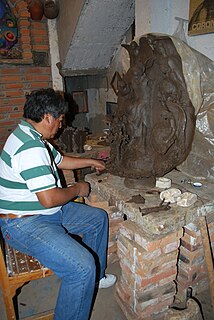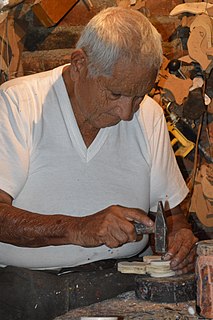The Plácido Otilia family is a Mexican family which specializes in the making of traditional musical instruments for the Huapango music of the La Huasteca region.(grandes) The family lives in Texquitote, Matlapa, San Luis Potosí and headed by patriarch Eustacio Plácido Otilia, an ethnic Nahua. [1] [2]
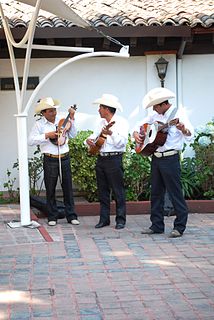
Huapango is a Mexican folk dance and music style, part of the style son huasteco. The word may be a corruption of the Nahuatl word cuauhpanco that literally means "on top of the wood", alluding to a wooden platform on which dancers can make zapateado dance steps. It is interpreted in different forms, the most common being the classic huapango interpreted by a trio of musicians ; the huapango norteño interpreted by a group ; and the huapango de mariachi, which can be performed by a large number of musicians.
Matlapa is a town and municipality in San Luis Potosí in central Mexico.
The family produces mostly string instruments such as violins, jaranas, tiny guitars called mosquitos, ravelitos and quintas, known for the quality of the sound. They are particularly known for their charangos, a guitar like instrument backed by an armadillo shell. [1]

The jarana huasteca, jarana de son huasteco or jaranita is a string instrument. It is most often called simply jarana.
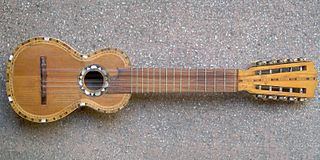
The charango is a small Andean stringed instrument of the lute family, which probably originated in the Quechua and Aymara populations in post-Colombian times, after European stringed instruments were introduced by the Spanish during colonialization. The instrument is widespread throughout the Andean regions of Ecuador, Bolivia, Peru, northern Chile and northwestern Argentina, where it is a popular musical instrument that exists in many variant forms.
Eustacio Plácido Otilia learned the craft from his father and has continued the tradition, teaching generations of his family as well as others in the community, giving classes at the local Juan Sarabia School. [1]
The family prefer to work with fine woods such as cedar, palo escrito and palo de rosa, matching the size of the raw wood to that of the finished product, in order to get the best sound. [1]

Dalbergia is a large genus of small to medium-size trees, shrubs and lianas in the pea family, Fabaceae, subfamily Faboideae. It was recently assigned to the informal monophyletic Dalbergia clade : the Dalbergieae. The genus has a wide distribution, native to the tropical regions of Central and South America, Africa, Madagascar and southern Asia.
Ottoschulzia rhodoxylon is a rare species of tree in the family Icacinaceae known by the common name pincho palo de rosa. It is native to Puerto Rico and Hispaniola. When it was listed as an endangered species under the United States' Endangered Species Act in 1990 there were only nine individuals remaining on Puerto Rico.
The family was named as “grand masters” by the Fomento Cultural Banamex in the 2000s. [1] In 2010, Eustacio placed third in musical instruments at the XXXV Edición Gran Premio Nacional de Arte Popular Bicentenario 2010 sponsored by FONART [3] and third in the same category at the Gran Premio de Arte Popular 2010 sponsored by SEDESOL and others. The latter award was for a “teponaxtle” a pre Hispanic instrument used during droughts to call rain in the San Luis Potosí part of the Huasteca region. [2]
